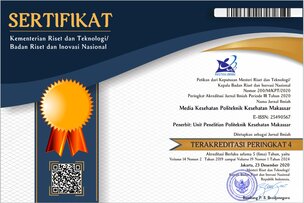THE INFLUENCE OF CHILDREN'S DENTAL CARIES ON THE QUALITY OF LIFE IN STUDENTS IN SUB URBAN AND URBAN ENVIRONMENT
Abstract
Dental caries is a major problem of dental and oral health which most often occurs in children. If neglected, dental caries can cause pain, infection, premature tooth loss, and chewing disorders which can interfere with the consumption of an adequate diet. Furthermore, this will affect the child's growth and overall contribution to the environment. This can lead to weight loss, sleep disturbances, changes in behavior, and poor school performance, which will have an impact on the quality of life of the child. The purpose of this study was to determine the effect of dental caries in children on the quality of life of students in suburban and urban schools. This research is an analytic observational study with cross-sectional design and involved 257 samples with total sampling method. Dental caries was measured by the DMF-t index and children's quality of life was measured using the Child Perceptions Questionnaire (CPQ8-10). The results showed that in suburban schools, the number of respondents with "high" caries severity had the highest number, namely 47 people, while in urban schools, respondents with "moderate" caries severity level had the highest number, namely 42 people. Based on statistical tests using regression test, it was found that dental caries has a significant effect on the quality of life of students in both suburban and urban schools (p <0.05). It was concluded that dental caries has a significant effect on all quality of life domains.
Key words: dental caries, quality of life, age 8-10 years.
Full Text:
PDF (Full Text)References
Alsumait A, ElSalhy M, Cor K, Gokiert R, Al-Mutawa S, Amin M. 2015. Impact of dental health on children’s oral health related quality of life: a cross sectional study. Health and Quality of Life Outcomes 13:98.
Andegiorgish AK, Kifle MM, Mebrahtu FG, dkk. 2018. Oral Health Related Quality of Life among Eritrean Children using the Short Form Child Perception Questionnaire. EC Dental Science 17(6): 836-42.
Aragannal P, Mahadev SK, Jayaprakash J. 2016. Prevalence of dental caries among school children in Chennai, based on ICDAS II. Journal of Clinical and Diagnostic Research 10(4).
Arora B, Khinda VI, Kallar S, Bajaj N, Brar GS. 2015. Prevalence and Comparison of Dental Caries in 12 year old school going children in rural and urban areas of Ferozepur city using sic index. Dental and Oral Craniofacial Research 1(2):38-41.
Babu SM, Nirmala SV, Sivakumar N. 2011. Oral Hygiene Status of 7-12 year old School Children in Rural and Urban population of Nellore District. Journal of The Indian Association 18(3): 1075-80.
Deynilisa S. 2016. Ilmu Konservasi Gigi. Penerbit Buku Kedokteran EGC.
Filstrup. 2003. Early Childhood Caries and Quality of Life:Parent Perspectives. Pediatric Dentistry, pp. 431-440.
Genderson MW, Sischo L, Markowitz K, Fine D, Broder LH. 2013. An Overview of Children’s Oral Health-Related Quality of Life Assessment:From Scale Development to Measuring Outcomes. Caries Res 47(1): p. 13-21.
Hiranya MP, Eliza H, Neneng N. 2011. Ilmu Pencegahan Penyakit Jaringan Keras dan Jaringan Pendukung gigi. Jakarta: EGC, pp: 104.
Kidd EA, Fejerskov. 2016. Essentials of Dental Caries. 4th ed. New York: Oxford University Press: 2-11.
Malohing D, Anindita P, dan Gunawan P. 2013. Status Karies Pada Gigi Berjejal di SD Negeri 12 Tuminting. Jurnal e-GIGI 1(2), p.95-8.
Martins MT, Sardenberg F, Vale MP, Paiva SM, Pordeus IA. 2015. Dental caries and social factors:impact on quality of life in Brazilian children 29(1):1-7.
Merdad L, El-housseiny A. 2017. Do children’s previous dental experience and fear affect their perceived oral health-related quality of life (OHRQoL). BMC Oral Health: 17-47.
Nazdrajic AH. 2012. Validation of child perceptions questionnaire 8-10 in Bosnia and Herzegovina. Mat Soc Med 24(3): 157-61.
Papaioannou W, Oulis CJ, Latsou D, Yfantopoulos J. 2011. Oral Health-Related Quality of Life: What, Why, How, and Future Implications. International Journal of Dentistry: 1264–71.
Ramayanti S, Purnakarya I. 2013. Peran makanan terhadap Kejadian karies Gigi. Jurnal Kesehatan Masyarakat 7(2):89-93.
Reddy KS, Rapala H, Kethneni B, Reddy H, Reddy A, Ravindhar P. 2017. Prevalence of dental caries in school going children of both urban and rural areas in Mahbubnagar district, Telangana State (India). Int J Pedod Rehabil: 7-13.
Sondang P, Hamada T. 2008. Menuju gigi dan mulut sehat. Medan: USU Press. pp: 4-15.
DOI: https://doi.org/10.32382/medkes.v15i2.1666
Refbacks
- There are currently no refbacks.
Copyright (c) 2020 Media Kesehatan Politeknik Kesehatan Makassar

This work is licensed under a Creative Commons Attribution-NonCommercial-NoDerivatives 4.0 International License.
Published By : Poltekkes Kemenkes Makassar
Office : Jl. Wijaya Kusuma Raya No. 46 Banta-Bantaeng, Kota Makassar, Sulawesi Selatan, Indonesia
Email : mediakesehatan@poltekkes-mks.ac.id
Media Kesehatan indexed by :
Protected By  |  |

This work is licensed under a Creative Commons Attribution-NonCommercial-ShareAlike 4.0 International License.




